Exclusive Interview With Stephanie Rew, 3rd Prize Winner of the Raymar Traditional Art Award, 2023 Beautiful Bizarre Art Prize by Aurore Phipps
Meticulous. Sensitive. Obsessive. Those are the three words that Scottish painter Stephanie Rew used to describe herself. It is true that her paintings, just like herself, reflect a certain punctiliousness, a tension towards a higher aesthetic purpose. Stephanie Rew’s brush is sober yet expressive tracing the contours of melancholic maidens.
She paints with a sort of romanticism materialized with the wavy, floating mane of the women on the canvas. Their averted gazes, their piercing eyes, their delicately embroidered dresses adorned with gold form a tapestry of life which tells stories simply waiting to be told.
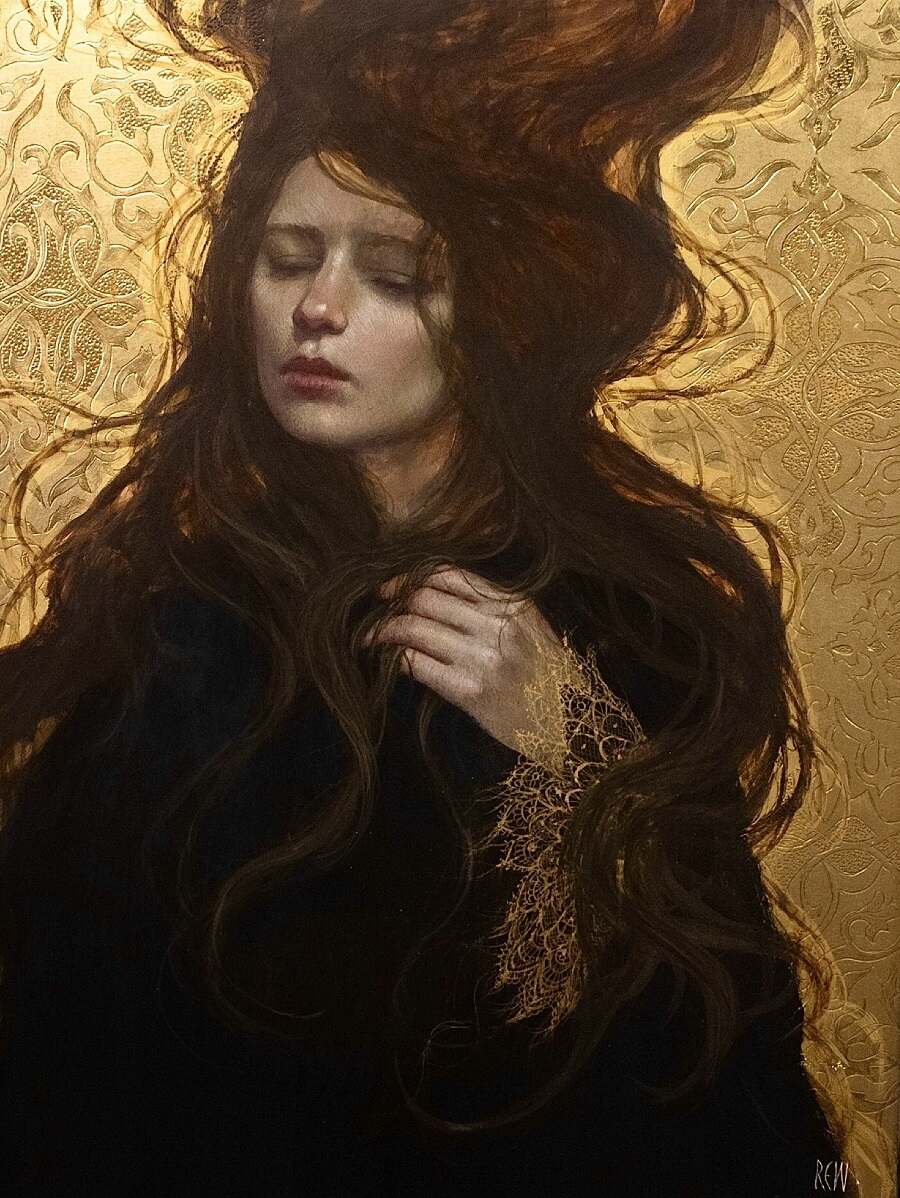
Egg Tempera and 24ct Gold Leaf on Poplar
30x40cm
Beautiful Bizarre Art Prize 2023 RAYMAR Traditional Art Award
Painting in the figurative realist style she incorporates oil paintings with gold leaf, combining traditional Early Renaissance gilding techniques with more contemporary ways of painting. This ability to bridge the gap between Ancient worlds and new ones, is a testament to Stephanie Rew’s deference towards her own artistry and that of artists before her. This attuned way of approaching art showcases Stephanie Rew’s inner artistic sensibility, oftentimes bordering on obsessiveness in an attempt at grasping the essence of her identity.
Indeed, the identity of the artist is a creation in perpetual progress; an inventive journey towards a “self” which only ends in the reconciliation of the artist with their art but most specifically themselves. This is why only the artist can take charge of their identity or embody it: as if they could make life burst out of the ideas that float around their sense of self. Let us take a look at Stephanie Rew’s specific artistic journey and see all the ways, in which she brings life and sense to her artistic process.
Stephanie Rew was featured in Beautiful Bizarre Magazine’s 14th curated exhibition, Halcyon Days, a year ago. And this year, she gracefully accepted to answer our questions as the 3rd Prize Winner of the Beautiful Bizarre Art Prize.
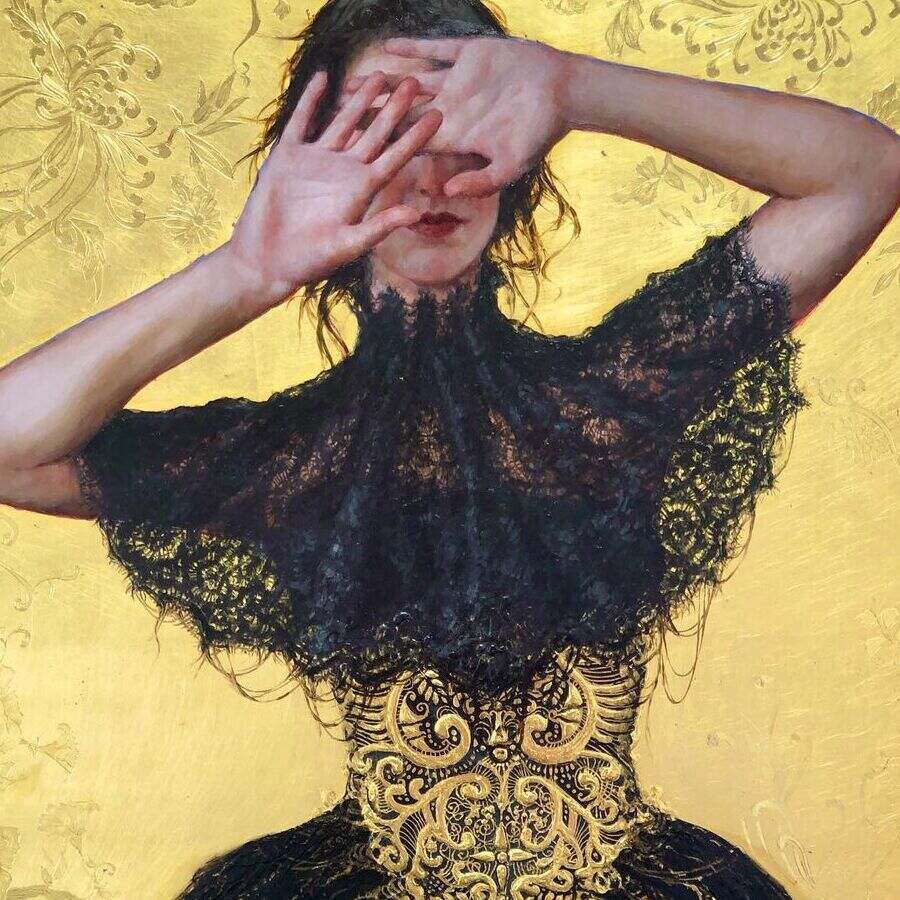
Drawing and painting to me is a language, a way to express myself and process my own thoughts in a creative way.
How would you define or characterize your journey as the artist Stephanie Rew?
As an artist I work instinctively. Painting is an obsession and when I’m not actually painting, I’m usually thinking about it. I welcome a challenge and learning new skills. Gilding is a fairly difficult process that offers up so many possibilities to the design of my work. It certainly keeps me interested and inspired.
I think as I get older, I’ve become more comfortable with the subject matter I choose. As a younger artist I was too worried about what other people thought was ‘good art’, and as a result I didn’t embrace my own personal aesthetic fully. I loved the Pre Raphaelites, The Scottish Arts and Craft movement as well as Japanese Ukiyo-e and the Secession painters of the Art Nouveau period but this kind of decorative art was seen, in the 90’s, by my peers and mentors, as deeply unfashionable, too sentimental, and trite.
I personally loved the romance, poetry, and sense of history in this kind of work. I also have always enjoyed fine art that involves elements of traditional craft. As I have matured as an artist, I embrace my love for the decorative arts and celebrate art that is beautiful for the sake of being beautiful.
Have you always known you wanted to be a painter?
I’ve always wanted to be an artist, as a small child I was always drawing something. I went from school to art college happily ignorant about how I might make this a career. I just worked every day to improve. Drawing and painting to me is a language, a way to express myself and process my own thoughts in a creative way. It’s not something that I have any control over anymore, but I know if was without it I would be miserable.
Female characters in my paintings are sometimes idealized and often romanticized but they are always strong.
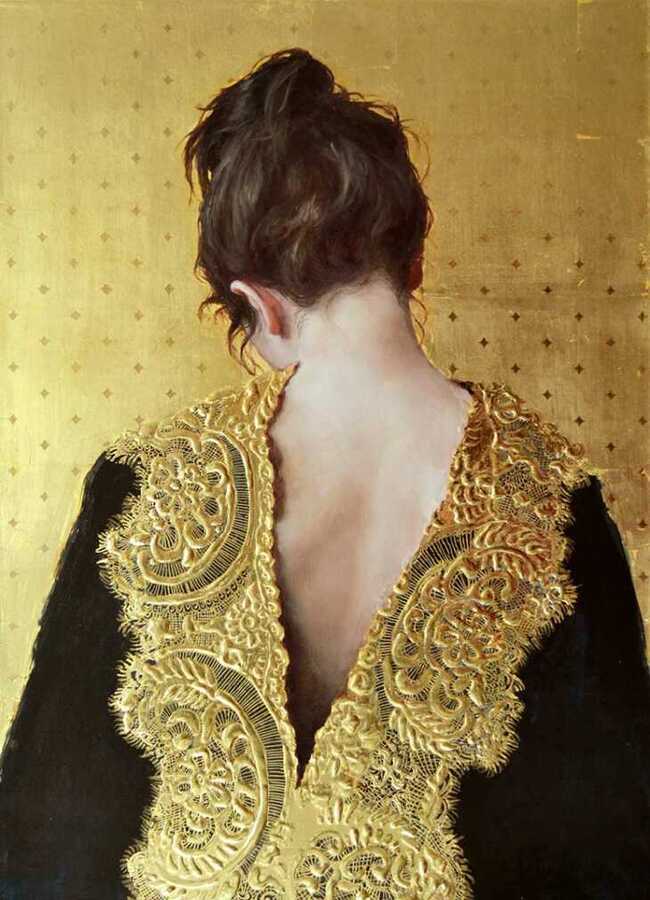
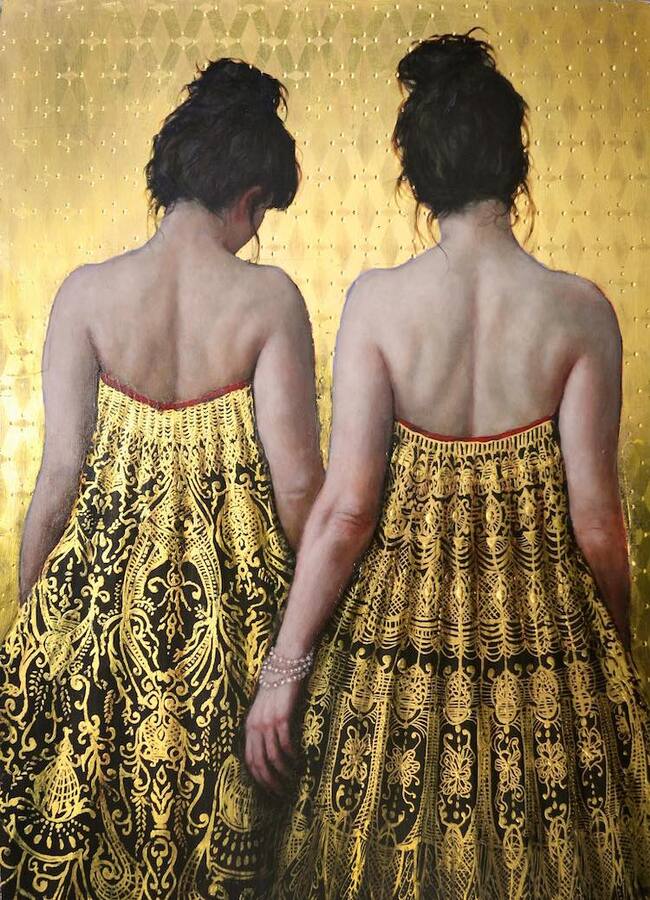
Your use of gold leaf is quite striking and refined and falls within a centuries-long artistic tradition with artists such as Klimt…where did your desire to create with gold leaf stem from?
The use of gold as an embellishment to painting has been an interest to me for a long time. Any artwork that combines pattern and decoration with a figurative element is interesting to me. I started using gold as a small area of embellishment and over the years the gold has become the dominant element in my paintings.
I was first inspired, back in my college days, by Scottish artist Margaret Macdonald’s gesso panels, and loved that she combined low relief gesso with painting. A few trips to Italy and Spain to see icon altarpieces and frescoes just made me more determined to find out more about gesso and gilding. The more I learned about gold the more interesting it became.
I researched endlessly online to find instruction, which led me to very old artistic water gilding techniques used by the icon artists of the early renaissance. Some of the processes I use are unchanged since the Egyptian era. I find working this way helps me make sense of where I am in the artistic timeline. I find that comforting. The physical process of gilding, the preparation of the gesso, sanding of the panels, laying of the gold, burnishing, and hammering into the surface is very satisfying work.
I considered taking sculpture instead of painting at college because I love to build and work in 3 dimensions, but I loved colour more and just couldn’t give that up, so I choose painting. The need to hand craft something physically is still there though, so gilding satisfies that part of my creative mind. It takes such a long time to make these panels, as it is slow and meditative work, that it gives me the time to really think about what I want my paintings to convey.
How important it is for you to represent women in your art?
I choose to paint women because I, Stephanie Rew, am one. It’s what I know. Telling her story is something I feel comfortable with. Female characters in my paintings are sometimes idealized and often romanticized but they are always strong. I strive to paint contemporary people but at the same time maintain a strong sense of history. A narrative is not too important in my work, these women are primarily symbols of femininity and strength.
What do you want people to take from your art? What is the journey you, Stephanie Rew, want viewers to embark on?
When I go to galleries, I instantly feel comforted, the art on the walls reminds me that humanity never really changes, and that people will always seek out beauty to lift their souls. I want viewers to feel uplifted by my work, or at least intrigued as to the story it is telling. I tell half the story in my paintings; I want the viewer to complete the other half themselves.
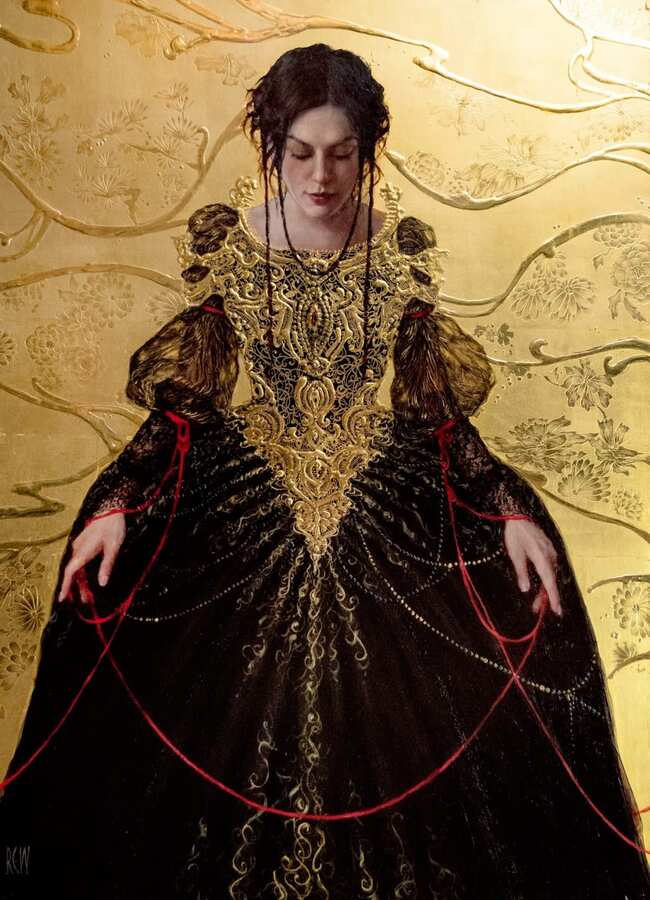
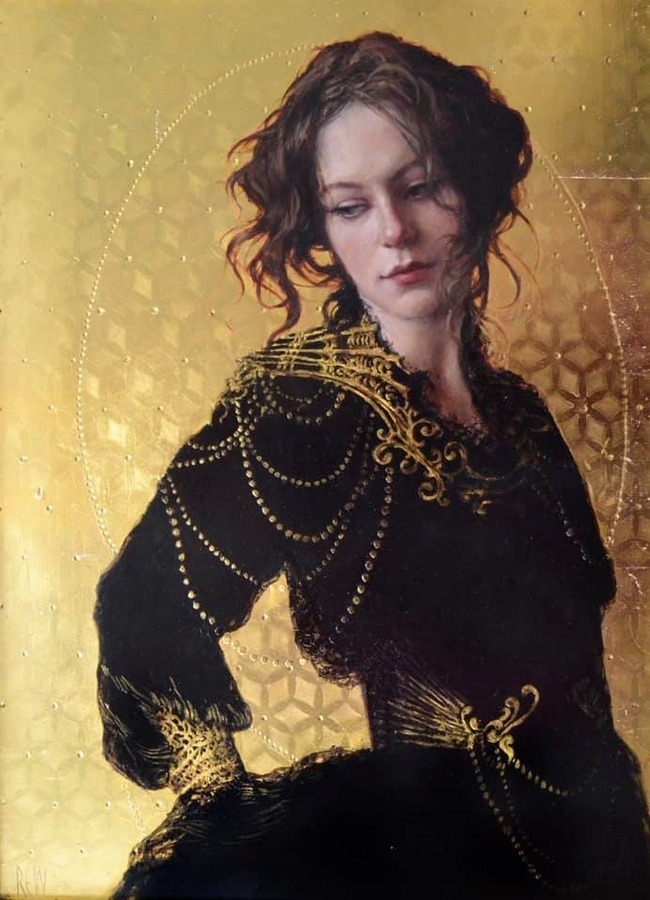
I think I am a bit of a workaholic, but painting begets painting. I can’t see the end to the process, so I just keep going. It’s a nice way to be.
Walk us through a typical day of creation so readers can have a more detailed idea of your creative process on a practical/technical level?
I usually work 9-5pm 5-6 days week, much like a proper job! Although I know it is not a proper job! My studio is in Coburg House Studios in Edinburgh and have been here for 22 years. I’ve rented here longer than any house I have lived in. It is a big building near the Leith Shore and is full of other artists and makers and is a very cheery and friendly place.
I tend to work on a few things at a time – in the run up to my solo show this year I had 12 paintings on the go at once. This way I can work on one while another is drying. Painting this way also gives the body of work a cohesion as if they are part of the same family.
When working on a water gilded panel there’s a lot of preparation takes place before I even start with the gold leaf.
I make my own panels with rabbit skin glue gesso. This process needs 12-15 layers of gesso and once this has dried, I sand the surface to get a marble like finish. This is tedious work, so I often listen to podcasts while doing this – I am going through a bit of a true crime phase at the moment.
I might engrave the design and pattern into the gesso with a dry point tool then water gild the surface. There are lots of different finishing techniques with gold leaf, I like to use a burnisher and a punch tool to hammer patterns into the gold.
Then I paint – this has become the easy bit to be honest! It can take 2-3 months to make a gilded panel – a large panel taking 6 months to complete. I set up photo shoots in my studio every few months and I usually ask friends or studio mates to pose for me and recently I have been working with dancers which is just lovely. I think I am a bit of a workaholic, but painting begets painting. I can’t see the end to the process, so I just keep going. It’s a nice way to be.
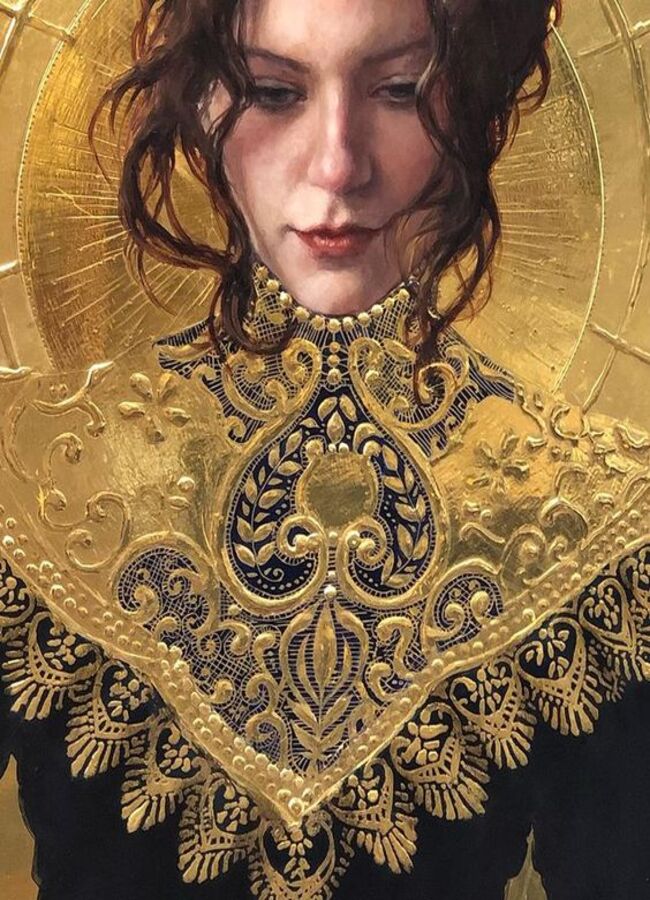
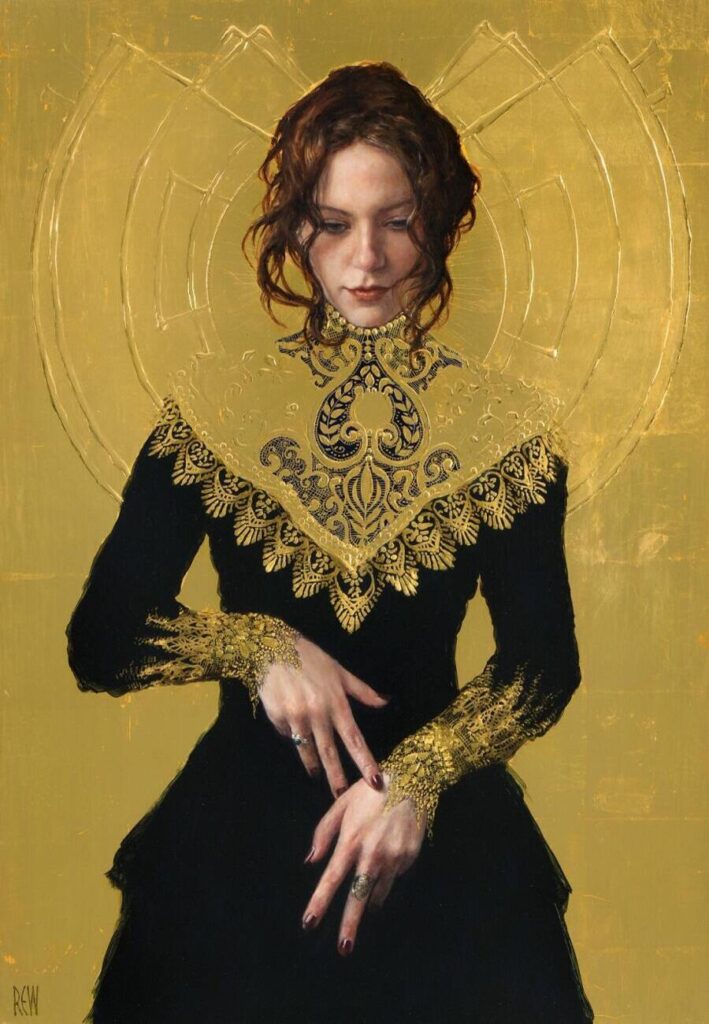
Your painting ‘Sail to Me’ seems to be a materialization of deep longing and melancholic solitude… a sort of ode to yearning? Would you agree with this characterization?
‘Sail to Me’ is the first of a series of paintings inspired by the song ‘Song to the Siren’ by Tim Buckley. The folklore of the Sirens is so poetic. She is full of longing and pain, and although she is an incredibly powerful entity, she finds she is vulnerable when she’s searching for love. There’s a softness to her as she resigns herself to her fate. So yes, your take on my painting is pretty much spot on.
Why did you, Stephanie Rew, enter the Beautiful Bizarre Magazine Art Prize?
I have been reading Beautiful Bizarre Magazine for quite a few years. It is one of the rare publications that promotes figurative and imaginative art, I have found many artists that I have since followed in this magazine. Their ethos in promoting new emerging artists and creating a community for artist in all mediums is a special thing.
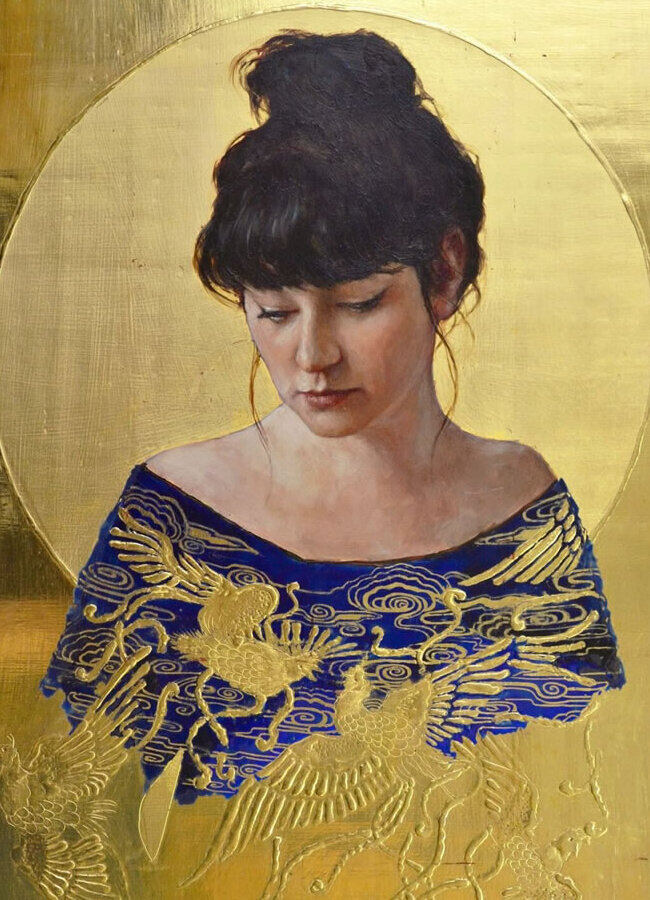

What do you feel you have gained from this experience?
I feel I have acquired a lot more visibility because of the BBM magazine articles and features as well as taking part in some lovely group shows with Corey Helford Gallery, Haven Gallery and Modern Eden. This alone has helped get my name out there. I have gained a few big commissions off the back of winning People’s Choice Award two years ago, so hopefully being awarded 3rd prize in RayMar Traditional Art this year will lead to more exciting exhibitions and opportunities.
Would you, Stephanie Rew, recommend it and encourage others to enter? If so, why?
Absolutely! I would recommend entering this competition to anyone regardless of what stage you are in your career, the standard is high but obtainable, and there’s a real opportunity to get your work seen on an international platform. It is a forward-thinking organization who actively promotes young emerging artists alongside established names in the business.
